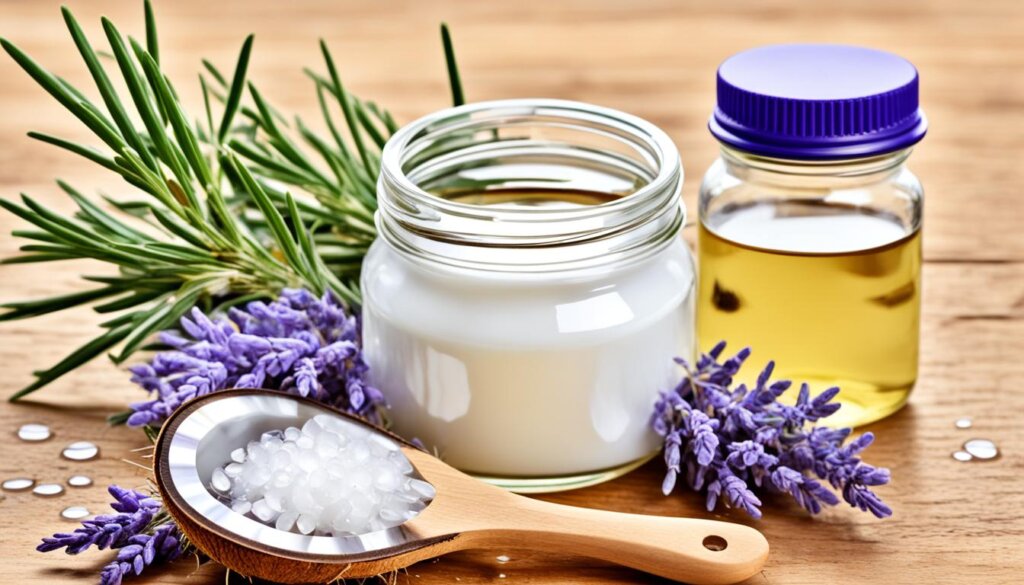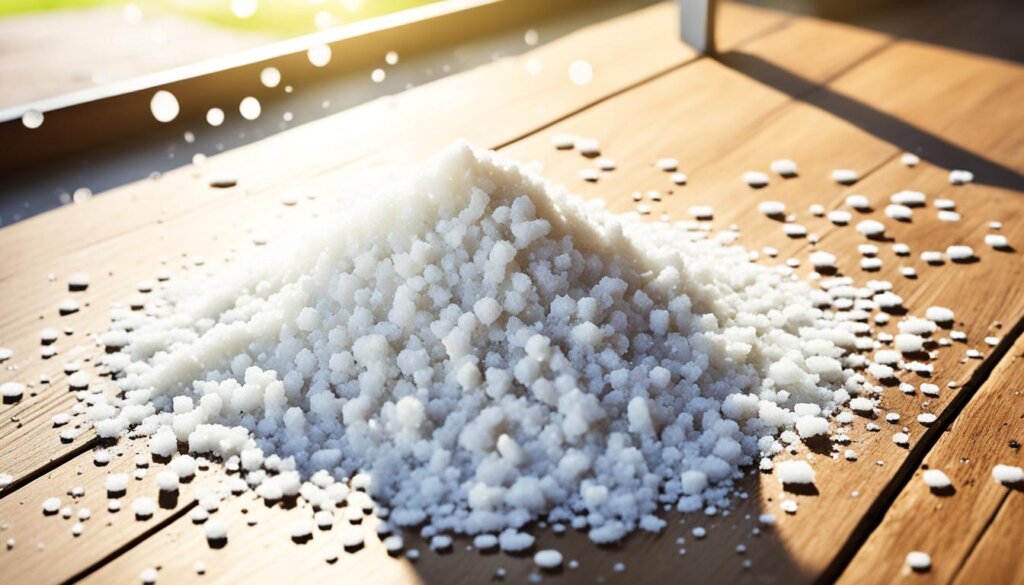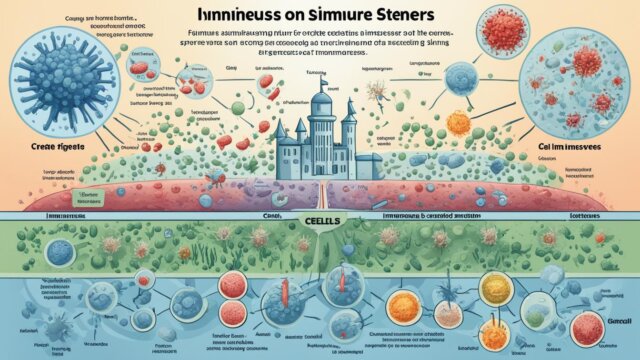FTC disclaimer: This post may contains affiliate links and we will be compensated if you click on a link and make a purchase.
Fleas are a big issue for those with pets. They can lay many eggs, up to 2,000 in their life. So, pet owners often find them hard to get rid of. Luckily, there are ways to fight fleas at home. This article shares natural flea-fighting methods to help keep pets safe.
Did you know fleas can live without pets? They jump on just to feed. Yet, keeping things clean helps a lot. Regular cleaning and some tricks can stop fleas from coming back. You can use things like homemade flea treatments, pet-friendly flea remedies, and eco-friendly flea management. These keep your home and pets safe from fleas.
Key Takeaways
- Fleas can quickly become a major nuisance, causing discomfort and potential health risks for pets.
- Home remedies can effectively eliminate fleas without relying on harsh chemicals.
- Regular cleaning, vacuuming, and washing pet bedding are essential for controlling flea infestations.
- Natural ingredients like citrus, herbs, and essential oils can repel and kill fleas.
- Diatomaceous earth, baking soda, and salt are also effective DIY flea solutions.
Understanding the Flea Life Cycle
Fleas change through four main stages: eggs, larvae, pupae, and adults. It’s key to know this cycle well. Why? Because you need to combat every stage to stop fleas from coming back and continuing their life cycle.
Eggs, Larvae, Pupae, and Adult Fleas
About 50% of all fleas in an average home are in the egg stage. The eggs become larvae, making up roughly 35%. Next, the pupae stage, which is about 10%. Finally, adult fleas are less than 5% of the total. An adult female flea can lay up to 40 eggs each day.
Interrupting the Life Cycle for Effective Control
By breaking the flea life cycle, pet owners can effectively control fleas. Larvae will make cocoons in 5-20 days if things are right for them. Fleas mainly live on their host, where they feed, mate, and lay eggs. They can stay there from a few weeks to several months.
To tackle a flea problem, treat your pets with a vet’s advice for at least 3 months. Use cleaning products on carpets, baseboards, and floors. These are areas where flea eggs and pupae hide. This helps control the infestation. Keep up with flea prevention, following the directions for at least 3 months. This really works to reduce fleas.
Fleas on cats and dogs are noticeable by their extra scratching or black specs. Look for these on fur or bedding. Use flea treatments that stop the life cycle. When you vacuum, you help eggs and pupae hatch, making it easier to get rid of them.
“95% of a flea infestation is found in the environment (carpets, floorboards, skirting boards) while only 5% is on the pet.”
How Fleas Find Their Way Onto Your Pets
Fleas are a big problem for pet owners. They can jump on your pets from many places, making it hard to get rid of them. Knowing how they do this helps us stop fleas from coming in.
Fleas love warm weather and are found a lot in spring and summer. Your pets might pick them up outdoors, like in parks or your yard. Once on your pet, fleas start feeding fast, and they can jump on you too.
Fleas can move from one pet to another easily. This happens a lot between dogs and cats. When pets meet, they can share fleas. This makes the problem worse if not stopped early.
Places like dog parks and your home can hide fleas. If your pet sleeps with you, it might make things worse. Fleas love hiding in furniture and are hard to get rid of once inside.
Understanding how fleas get in and spread helps a lot. To keep them away, regularly groom your pets and clean your house. Using flea products also helps prevent their return.
“Fleas are a persistent problem for pet owners, but with the right approach, we can keep our homes and our beloved pets flea-free.”
Health Risks of Flea Infestations
Flea infestations are not safe for pets or people. They can cause a lot of itching. People may feel itchy because of the flea bites. These bites are red and itchy, with a red spot and halo. You might see them on your lower legs, ankles, and feet. Scratching can make the skin sore and even cause infections.
Getting bit by fleas can lead to a serious skin condition called flea allergy dermatitis (FAD). It makes many pets react badly to flea saliva, causing big red spots and discomfort. Without proper care, too many fleas can make pets tired and weak from the blood loss.
Fleas can bring problems for people, too. Even though they don’t live on us much, their bites can make us swell and itch. There’s also a risk of getting sick from fleas, like getting typhus or plague.
Dealing with fleas quickly is key for everyone’s health. Regular grooming and cleaning your home can help a lot. Using products to control fleas is also important. If you think you have a flea problem, or if you’re getting sick, see a vet or doctor right away.
Preventive Measures to Reduce Flea Infestations
To keep fleas away from your pet and house, it’s best to be proactive. Start by grooming your pet often. This includes brushing and combing their fur regularly. Also, be sure to vacuum your home thoroughly. Doing these things helps stop fleas from becoming a big problem.
Don’t forget to wash your pet’s bedding too. And, use ways to control fleas in your home. This prevents your space from becoming a place where fleas thrive.
Regular Grooming
Regularly brushing and combing your pet’s fur has many benefits. It not only keeps them looking nice but also helps get rid of fleas and their eggs. As a result, it can prevent a flea infestation before it starts.
Flea Comb and Vacuuming
Using a flea comb helps check your pet for fleas and remove them. It’s a detailed but necessary step in flea control. Vacuuming your home also plays a big part. Make sure to vacuum areas your pet hangs out in. This action removes flea eggs and larvae, interrupting their life cycle.
Washing Bedding and Environmental Control
Washing your pet’s bedding often in hot water can kill fleas and their young. Keeping your living spaces clean and free of clutter is key. This makes it harder for fleas to find hiding and breeding spots.
By following these steps, you can lower the chances of dealing with a flea problem. Not only does this keep your pet safe, but it also creates a better environment for everyone. Remember, prevention is the key.
Lemon Bath for Flea Elimination
Having lots of fleas on your pet can be tough, but there’s a simple trick – a lemon bath. Lemons have citric acid that fleas don’t like, so it helps a lot.
Making a lemon flea bath is easy. You will need 3 lemons, 3 cups of water, and 1 ½ cups of vinegar. Cut the lemons and put them in the water. Let it sit overnight, at least 8 hours. Then, boil it for 30 minutes and take out the lemon pieces.
Next, wash your pet with the lemony water. Rub well where fleas like to hide, like their neck and belly. This bath will make your pet feel better from the itching of flea bites.
You should also rinse your pet well after the lemon bath. Wash their bed, toys, and any place they lay, to kill flea babies. Vacuum often to keep your home free of fleas.
Keep fleas away by using the lemon spray and bathing your pet often. Also, clean your home and your pet’s things regularly to stop more fleas. If your pet gets itchy, stop using lemons right away. But, most pets and homes do well with lemon against fleas.
Apple Cider Vinegar Spray
Got a flea problem with your pet? Apple cider vinegar (ACV) could help you out. It’s a common home cure because it makes a skin that fleas hate. ACV’s strong smell is bad news for fleas, so it’s a good way to keep them away.
Making the ACV spray is easy. Mix the same amount of ACV and water in a spray bottle. Then, spray it on your dog’s fur, but be cautious near the eyes and ears. ACV’s acid stops fleas and can prevent them or fight an infestation.
Remember, ACV doesn’t kill fleas, but it makes your pet’s fur a less fun place for them. Yet, some pets might not like it or get skin issues. So, it’s smart to talk to your vet before using ACV or any home solution.

When using ACV on your pet, watch for any bad reactions. If your pet gets irritated, stop using it and see your vet. With care and some testing, ACV might just be the natural and affordable answer for fleas.
Rosemary Dip
Want to keep fleas away safely? Try rosemary! It’s a well-known herb that keeps fleas off naturally because of its special ingredients. Making a rosemary dip is easy. You just have to boil rosemary leaves, let it cool, then dip or spray your dog. Rosemary’s smell makes fleas not want to come close.
Rosemary is safe for most dogs. But, some kinds like Collies and Shelties might get sick. They could have seizures if they touch it. Watch your furry friend for any bad signs. And if you see something worrying, ask a vet. This dip is an eco-friendly way to fight fleas instead of using harsh chemicals.
To make the dip, boil water and then add rosemary leaves. Let it simmer for 10-15 minutes. After that, let it cool. Now, you can dip your dog or use a spray bottle. It’s a good idea to use this dip often to keep fleas away from your pet.
“Rosemary is a great natural treatment for fleas, and the dip is simple and safe for most animals. Remember to watch for any breed issues and to ask your vet for advice.”
Don’t forget, using rosemary alone isn’t enough to stop fleas. You should also brush and clean your pet’s things regularly. Doing these things together helps to really stop fleas. Plus, it keeps your pet feeling good and well.
Herbal Flea Collar
Keeping your furry friend free from pesky fleas doesn’t need harsh chemicals. Making a homemade herbal flea collar is natural and smells good. It’s easy to make and a great step away from traditional flea collars.
First, pick a fabric pouch to make your collar. Fill it with dried herbs that fleas don’t like, like lavender and rosemary. Then, put the bag around your pet’s neck. Make sure it’s snug but comfy. The herbs’ natural smells will help ward off fleas. This gives your pet a natural shield against them.
Choose herbs with strong repellent powers for your collar. Cedarwood and peppermint oils are good picks. They keep fleas and ticks away for up to 4 months. These herbs make a protective border around your pet’s neck. This protection can help stop fleas from coming near.
Keep an eye on your pet’s skin when using the collar. Make sure there are no bad skin reactions. Talk to your vet if you worry about using the herbal collar. With the right herbs and a gentle touch, this DIY remedy is a safe and good way to fight off fleas.
Making your own herbal flea collar is simple. It helps keep your pet safe from fleas and their dangers. By using natural ingredients, you offer a longer-lasting solution. Plus, it fits well with caring for your pet naturally.
Coconut Oil Rub
Coconut oil is great for keeping fleas off dogs. Warm a bit and apply on the dog’s fur. It does two jobs well – moisturizes and fights fleas. Since it’s oily, fleas have trouble living on the dog. This keeps the pet safe from fleas when used regularly.
Moisturizing and Suffocating Fleas
Lauric acid in coconut oil stops fleas from biting. It’s safe because it’s natural without harsh chemicals. The use of coconuts has grown because they’re healthy for us and our pets. Coconut oil is often enough to get rid of mild flea problems. But, for a big issue, you may need to apply it every day.
Coconut oil has even more good effects for dogs. It gives them extra energy, stops itching, and helps with losing weight. It can also heal their skin cuts quickly because it fights off bad germs. The time when fleas are active can be hard for dogs. So, it’s good to know about coconut oil for tackling this issue naturally.

“Coconut oil is a great, natural choice for fighting off pests. It kills fleas and ticks safely, without the bad parts of chemicals. For many years, Filipinos have used coconut oil for flea, mite, and lice problems. It works by stopping the pests from moving well. CocoTherapy coconut oil, high in lauric acid, is especially good against strong flea and tick invasions.”
Essential oils can hurt cats, so vet advice is smart before using them near cats.
Diatomaceous Earth Powder
Looking for a natural way to get rid of fleas? Diatomaceous earth (DE) powder is your answer. It’s made from the remains of tiny sea creatures called diatoms. This powder is great at killing fleas and other bugs because of how it works.
Diatomaceous earth works against fleas by hurting their outer shells. This makes them dry up and die. Adults fleas can start dying in just four hours after touching diatomaceous earth. So, it’s a strong, safe choice for getting rid of fleas without using bad chemicals.
For fighting fleas, use food-grade diatomaceous earth. It’s safe for both pets and people. The powder kills fleas in a way that they can’t get used to or avoid. But, it only works against some of the fleas, not the eggs or young fleas.
To use it, just sprinkle the powder in flea-heavy places. These include pet beds, carpets, and spots in the house. Let it sit for up to two days, then vacuum it up. Make sure to keep the powder dry; it’s less strong when wet.
It’s safe around pets, but too much exposure can dry out their skin. Check with a vet before using DE if your pet has breathing problems. Also, wear protective gear to cover your face and eyes when you work with the powder.
Using diatomaceous earth can kill fleas naturally. Just don’t forget to apply it correctly, keep it dry, and protect your pets and family.
Diatomaceous Earth Benefits | Diatomaceous Earth Limitations |
|---|---|
|
|
Neem Oil Spray
Looking for a natural way to fight fleas and ticks on your pets? Neem oil spray might be what you need. It’s made from the neem tree and helps a lot.
Neem oil keeps fleas away and stops them from making more fleas. It smells strong but good for us. It’s safe for pets and the environment, unlike harmful chemicals.
Harnessing Neem’s Insecticide Properties
Neem oil’s magic comes from a substance it has called azadirachtin. This makes fleas and ticks confused and unable to have babies. They soon go away. Mix neem oil with water to spray on your pet. Focus on areas where fleas like to hang out.
Use neem oil carefully and watch your pet for bad signs. It’s usually safe, but check with your vet if your pet has special needs.
You can also use neem oil around your house and yard. Spray it on places where fleas hide to stop them from coming back.
Neem oil is a great natural way to fight fleas and ticks. It works well and is safe for your pets. Plus, it’s good for the planet too.
Salt Treatment
Salt is great for getting rid of fleas and is cheap. Adult fleas are very small, and baby fleas are even tinier. Flea eggs become tiny larvae, and then they can lay lots of eggs. Sprinkle salt on places like carpets where fleas like to be.
The salt makes the fleas and their eggs dry up and die. After a while, vacuum up everything. This helps with a big plan to stop fleas. Fleas don’t just hide in the house but also outside. They like places with shade, like under a porch or in the grass.
Using salt is cheap, unlike some chemicals, and it only costs a little money. It’s key to treat inside and outside, on pets too, to really beat the fleas with salt. Still, keep an eye out for any harm salt might do to pets or stuff.

“Salt can be an effective and affordable home remedy for eliminating fleas and their eggs in the home environment.”
Fleas grow from eggs to adults in different stages, which can take weeks to months. Eggs can become larvae very quickly, showing fleas grow fast. Larvae can wait to feed for a long time, which makes it hard to get rid of fleas.
A lot of people in the U.S. have pets, which can bring fleas inside. Using salt and other flea remedies helps keep pets and people happy.
Baking Soda for Carpets and Bedding
Baking soda is great for fighting fleas in your home. Mix it with salt to dehydrate and kill flea eggs and larvae. This stops the problem from getting worse. You should mix salt and baking soda together. Then, sprinkle it on carpets and bedding. Let it sit overnight.
After you let it work, vacuum very well. Doing this again in a few days helps get rid of new eggs. Remember to clean often. Vacuum your floors every day. Also, wash your bedding in hot water. This helps stop fleas from coming back.
If you have a lot of fleas or just want to stop them, use a special Flea & Tick Control Program. Or, get help from a pest control expert. This can really reduce the fleas and keep your home flea-free for a long time.
While baking soda is safe for pets, don’t put it on cuts or sensitive skin. Using baking soda helps a lot in fighting fleas. It makes your home better for you and your pets.
Vacuuming and Cleaning for Flea Control
Keeping your home flea-free needs many steps. Regular vacuuming and cleaning are key. Fleas and eggs hide in soft places like carpets. So, vacuum often to get rid of them. Aim to do this thoroughly 2-3 times weekly, until you see no more fleas.
Furry friends should get extra care in flea season. Make sure to clean where they sleep or relax often. For cat beds, use hot water to wash them. Sometimes it takes two washes, one with soap and another with vinegar. Plus, keeping indoor places clean is crucial for stopping fleas.
Don’t forget to comb your pets too. A flea comb works great, especially on cats. They use a special comb over a bright surface to catch and kill fleas. And although treating the yard is an option, it may have some worries.
Experts say you should treat fleas for about three months to stop them all. It’s hard work and may cost a bit but don’t lose hope. Stick to well-known flea treatments like Revolution or Bravecto.
To keep your home flea-free, clean and vacuum a lot. Treat your carpets every two weeks. It’s common to spot fleas after carpet care, so keep vacuuming.
Fleas don’t usually live outside long. Plus, some stages of fleas are hard to kill. So, work on pets and your house together to get rid of them.
Vacuuming also helps by sucking up flea eggs and young fleas. To win the fight against fleas, you might need to try a few methods. And, when you’re done vacuuming, empty the bag outside.

Knowing about fleas is key to stopping them for good. Fleas live up to 100 days. And a female flea can make 2,000 eggs in her life. In the perfect place, fleas grow up in 2-3 weeks and start to bite right away.
The baby fleas (larvae) can sleep for months if it’s not perfect for them. Clean fast and use flea treatments to kill many fleas quickly. But, getting rid of all can take time. Some fleas now even resist medicine and poison.
Some medicines work fast on fleas. Products like Frontline can kill a lot of fleas in hours. Pills like Bravecto or Capstar wait for the fleas to bite before they work. Shampoos with pyrethrin from chrysanthemums are also good.
Soap and Water Baths for Pets
One quick way to get rid of fleas is with a simple soap and water bath. With a pet soaking in the water, the fleas leap out to survive. It’s smart to use a flea comb too, especially on the head and neck. You can also drop some cedar or lavender oils in the bath to keep fleas away.
The best water temperature for pets is lukewarm, about 70°F (21°C). Use 2 to 3 teaspoons (9.9 to 14.8 mL) of dish soap. Let the soap stay on their fur for 5 minutes before rinsing. You might need to do this bath a few times if your pet has a lot of fleas.
If you want a stronger flea treatment, mix dish soap with lukewarm water in a spray bottle. Spray it on your pet, wait 5 minutes. Then dry them with a towel or a hair dryer on a low setting. Do this every few days until the fleas are gone.
Don’t forget to vacuum your pet’s spots regularly to stop fleas. Do this at least once daily to catch any fleas and eggs left.
“Soap and water baths are one of the quickest and most effective ways to remove fleas from your pet.”
Other Home Remedies for Flea
There are many natural ways to stop fleas. You can make flea traps with dish soap and water. Using essential oils like peppermint can keep them away. Also, keep your home clean by vacuuming often to stop fleas from spreading.
A flea comb is great for pet owners. It helps remove fleas and their eggs from pets. Vacuum your home a lot, especially carpets and furniture, to fight fleas. Finally, don’t forget to get rid of any extra stuff in your house. Fleas love to hide in clutter.
Another good step is to use diatomaceous earth. It’s a natural powder that repels fleas well. Making a lemon spray can also keep fleas away because they don’t like the smell. Salt can dry out adult fleas, but it doesn’t work on flea babies. Baking soda is good for killing fleas too. Just sprinkle it on, brush it in, and then vacuum well.
Using a flea trap with dish soap can catch a lot of fleas. This works because the soapy water is thick, and fleas get stuck. Some plants naturally keep fleas away. These include spearmint, lavender, and others. You can also make an herbal powder with rosemary to treat a light flea problem.
Combining different natural methods can get rid of fleas for good. Diatomaceous Earth is safe and effective against fleas. Oils like citronella are great for keeping fleas off pets.
Sometimes, DIY solutions may not work. In these cases, professional pest control can help. Lake Norman Home Services, for example, is known for their safe and affordable flea control.
Professional Pest Control Services
At times, flea issues are too big for home fixes. Then, pros can be a big help. These experts use special products to get rid of fleas. They also help stop fleas from coming back. And they make sure pets and people are safe for a long time.
When DIY Methods Aren’t Enough
Sometimes, flea problems seem to pop up fast. The fleas spread all over your place. Their bites aren’t usually painful but can cause itchy red bumps on skin. Fleas can be hard to control with store-bought stuff. This is because their life cycle makes it tough to kill them all at once.
Pro treatments work fast to cut down on adult fleas in your home. But, you might see more fleas soon after treatment. This is because younger fleas that were hidden start to show up. Vacuuming each day after the extermination can help get these fleas out for good.
Fleas love to lay their eggs where pets spend time. They like hiding in carpets and furniture. A flea can jump pretty high for its tiny size. They might not need pets to live but should be gotten rid of with daily vacuuming to prevent them from coming back.
To know how much it’ll cost to get rid of fleas, you have to know what kind of plan is best. Your local Orkin office can check your place for free and give you a cost. Vinegar doesn’t kill fleas well, but it can keep them away. Dish soap can help with live fleas on your pets. Orkin also gives a guarantee and checks back for free if needed. They tell you everything they did and how to keep your home flea-free.
Exterminating fleas typically costs $270 but can range from $75 to $400. If you need more than one treatment, it could be an extra $75 to $200 each time. Different services like vacuuming, flea bombs, sprays, fumigation, and heat treatments vary in price. But they can all help get rid of fleas.
Knowing how to tell if your pet has fleas is important if you want to stop an infestation. Looking for flea dirt, eggs, and the fleas themselves is key. Professional help is usually better than trying natural methods because it’s stronger and quicker. This can save time and money in the long run.
When you can’t beat fleas on your own, it’s smart to call in the pros. They have the right tools and know-how to get rid of fleas completely. They also make sure fleas don’t come back, keeping your home safe and comfortable.
Conclusion
Fleas are a big issue for pet owners. But by mixing natural flea remedies, prevention steps, and home flea removal tactics, you can beat them. You can find tips here like using lemon baths and apple cider vinegar. Also, you’ll learn about diatomaceous earth and neem oil.
This article tells you about natural flea solutions and the flea life cycle. Knowing this helps you protect your pets and keep your home free of fleas. Do regular grooming, vacuum, and wash pet stuff. Use natural repellents too. These steps really work against fleas.
Using DIY ways can help eliminate fleas at home. But, always ask a vet for advice. They can give you tips for bad infestations and offer their services. By managing fleas well, your home will be peaceful for you and your pets.
FAQ
What are the different stages of the flea life cycle?
Fleas go through four steps in their life cycle: eggs, larvae, pupae, and adult. Knowing these stages helps control fleas.
How do fleas find their way onto pets?
Fleas can jump onto pets from outdoors, other animals, or places like dog parks. It’s how they spread.
What are the health risks associated with flea infestations?
Flea bites can cause itchiness, allergies, and even anemia in pets. It’s important to prevent these issues.
What are some preventive measures to reduce flea infestations?
To minimize fleas, groom your pets regularly and vacuum. A clean home helps keep them away.
How can a lemon bath help eliminate fleas on dogs?
Lemon baths reduce fleas and itching. Simply add lemon juice to your dog’s bath and rub it into their fur.
How can apple cider vinegar be used to control fleas?
Apple cider vinegar repels fleas and calms skin. Mix it with water and spray your dog’s coat.
What are the benefits of using rosemary as a natural flea remedy?
Rosemary’s scent keeps fleas away. Dip a cloth in rosemary water and use it to pet your dog.
How can a homemade herbal flea collar help repel fleas?
Create a flea collar by filling a pouch with herbs like lavender and rosemary. It will make your pet smell nice and discourage fleas.
How can coconut oil be used to combat fleas on dogs?
Coconut oil moisturizes your pet’s skin and makes it hard for fleas to live on them. It’s a simple and natural remedy.
What are the benefits of using diatomaceous earth to eliminate fleas?
Diatomaceous earth dries out and damages flea’s bodies. Put it on your pet’s fur, leave it on, and then brush it out.
How can neem oil be used as a natural flea repellent?
Neem oil is good for killing fleas. Mix it with water and massage it into your dog’s fur.
How can salt be used to eliminate fleas and their eggs in the home?
To kill fleas at home, sprinkle salt and rub it in carpets and bedding. It dehydrates the fleas.
How can baking soda be used to combat fleas in the home?
Baking soda kills fleas and their eggs in your home. Spread it on carpets and furniture often.
When should pet owners consider seeking professional pest control services for flea infestations?
When flea infestations are too big to handle alone, professionals may be needed. They have the tools to solve the problem quickly.








